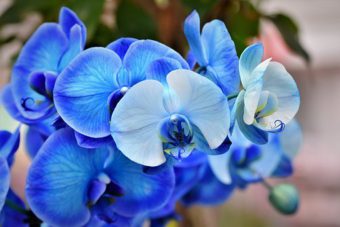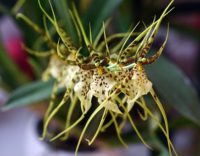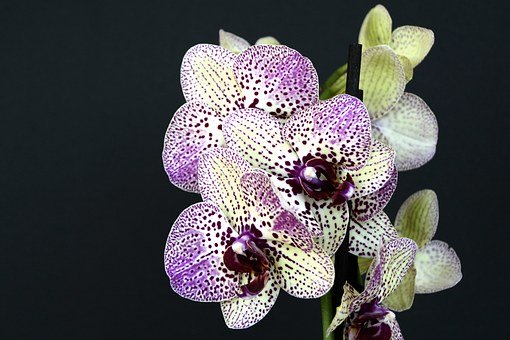In this first part of a two-part series, we will be discussing growing orchids as houseplants in particular in this first part on getting the growing conditions right.
The second part will go into more into the orchid plants that are best to grow as houseplants. It is no good talking about what houseplants to have if you do not get the basics right.
Orchids are fascinating plants, as they are some of the most beautiful houseplants you can actually buy. Orchids seem to come with a lot of baggage and this makes people believe in their own eyes that they are difficult plants, which makes a lot of people reluctant to buy them.

They are difficult to grow, they are too expensive, they are never fragrant or the flowers do not last a long time.
I am pleased to say that all of this perceived baggage are untrue, all of them. You can have an orchid in flower throughout the year. This is provided that you carefully select the right species and look after the plant carefully. They are more value for money, as compared to other houseplants you can often buy.
DO NOT BELIEVE THE MYTHS
Some myths are based on truths, as some of the most expensive plants ever sold in the world have been orchids. This does not mean that most homeowners cannot buy a specimen or two. Orchids are more value for money, as compared to other flowering houseplants as the time they are in flowers is much longer. They can be in flower for months instead of days or weeks found in other houseplants.
What surprises people are some orchids are scented, packing indoors with their odour of spicy and pleasant, or it can be putrid. The scent can be very strong or they can be delicate and barely noticed.
Some orchids are grown for the scent alone which can be produced either during the day or the night.
In the whole orchids have flowers in many colours and patterns that are produced throughout the year. This and the beautiful scent makes orchids some of the most desirable houseplants to have in your home.
WHAT IS AN ORCHID?
Orchids all have a distinctive floral and leaf features. They come in a range of sizes from 3cm to over 6m in height, with leaves that are large and makes a distinct feature. Apart from a few specimens such as Anoectochilus and Ludisia who have richly veined dark leaves, most are grown for their blooms.
Most cultivated orchids are epiphytes, which translates to mean ‘Upon a tree’. This implies that the plants grow on trees under a canopy of forests. The easiest way to recognise orchids are the fleshy, spongy water-absorbent tissue of the root. All orchids have it, where this tissue catches the moisture available to them.
THE BLOOMS ARE WHAT SET THIS PHOUSEPLANT APART
The blooms set orchids apart from other houseplants, with their richly coloured and exotically marked flowers. Orchids blooms also look different from other houseplants in that the flowers are arranged in whorls of three, where three sepals on the outer whorls encase the inner whorl of three petals.
The lip of the orchid flower is the showiest part of the plant that normally encases the upper petal.

Orchids have two growth habits: primitive and derived. The primitive habit involves the plant producing a horizontal rhizome from the base of which new growth emerges. This is shared growing habit with ginger, irises and bamboo have.
The flowering stem appears from the middle of the newest growth or from the axils of the leaves. The leaves may be succulent-like with pronounced thickening to form pseudobulbs for storage as for Cattleya or have sort leaves arranged in a fan, such as in paphiopedilum.
Derived orchids, on the other hand, grows straight up a long stem with one main apex. The flowering stem emerges from the axils of the leaves, which continuously develops from the active growth point. Growth is straight up as often found in palm trees.
ORCHIDS GROWING REQUIREMENTS
Orchids like other plants need light, air, water and food in the right quantities. There is no magic bullet to growing orchids successfully as each orchid have different needs. Some require more light, some require less. It is important therefore to understand how these four factors together can produce a healthy orchid producing quality flowers.

If a plant looks unhealthy it is best to feed and prevent any flowers from being produced. A sick plant will produce flower stalks as a last desperate attempt as a means of reproducing itself, if a poorly plant produces a flowering stalk then you know that the plants’ death will be around the corner.
Moth Orchids (Phalaenopsis) flowers over a long period of time until all the plant’s energy is used up and the plant dies. The problem is also made worse as well feed and looked after plants will have plenty of leaves but no flowers. You need to get the right balance to not under or overfeed orchids.
LIGHT
Light of good quality is very important in growing orchids at home. If an orchid does not flower during a growing season the major cause is insufficient light available to the orchid.
A common mistake is to believe that provided quality light over a long period of time, will overcome any shortcomings provided by poor quality light, but this is not true. Light of any quality will disturb the orchid growing cycle. In other words, the plant will not know what season it is and therefore will not flower.

Any light levels greater than 15 hours is harmful to orchids and this includes any artificial light that you may use.
The symptoms of too prolong light are similar to other stressed plant problems. The leaves tip burn or blacken the plant grows weakly and there are no flowers produced. It also does not look like a healthy plant.
DO NOT BE CONCERNED ABOUT LIGHT TOO MUCH
Most orchid growers will not need to be bothered about the light, as long as the growing area gets the same number of hours of light as if it was grown outdoors. Under these conditions, the plant will do fine.
If your orchids are in a basement or other area, where artificial light will be used then it is best to use a timer to switch on or off when the required amount of light is received. You have to make sure the orchids do not get more than 15 hours of light per day in total.
Gauging if the plant is getting enough quality sunlight is problematic. You can use light meters but this is costly and the figures they produce are not going to be totally reliable. A good indicator would be an African violet plant to see if the light is good enough to grow orchids in. If the American violet stays in flower for most of the year then the area will be suitable to grow orchids in.
You can use an old trick to measure light and save you money.
USE THIS TRICK
First place you hand up over the area you want to grow the orchid. The hand must be placed between the light source (i.e. the sun) and the hand so that a shadow is cast over the area that you wish for the orchid to be grown. If a strong, sharp shadow between the light source and the plant is observed, then the light is of good enough quality to enable any orchid to be grown, apart from those who like strong sunlight.
If the shadow that is formed is not as strong and has blurred edges, then the light will be sufficient to grow orchids that like moderate or lower lights growing conditions.
If no shadow is observed but you can tell the difference between if your hand is placed in front and when it is not, then you can grow orchids that will succeed in growing in the lowest light conditions such as Lady Slippers, Phalaenopsis, and Jewel Orchids.
MAKE SURE YOUR PLANTS DO NOT GET TOO MUCH LIGHT
It is also important to make sure that the plant does not get too much light so that the leaves are not blacked or scorched. This is more likely when the sun is getting higher in the sky and the seasons are turning from winter to spring.
In non-ideal light conditions, where the level of light cannot be controlled. Under these conditions, you will need to moderate light intensity by providing shade of some sort.
This is because bright light can be controlled via shading. This means that at facing windows are ideals for growing orchids in, or as curtained south-facing window comes a close second.
West-facing windows can work but sun in the late afternoon can be problematic. A north-facing window is unsuitable for nearly all orchids, apart from jewel orchids who can take deep shade at all times.
TEMPERATURES
The particular temperature preferred by any orchid is highly dependent on its native environment. Most cultivated orchids come from the tropics or sub-tropics where nighttime temperatures are between 15 and 20 degree Celsius, and daytime temperatures are between 26 and 35 degree Celsius. The orchids here can be found at sea level to over 3000m in elevation or more, so have to put up with a wide range of growing conditions.
Orchids traditionally grow in three temperatures: cool, intermediate and warm.
COOL, INTERMEDIATE OR WARM ORCHIDS?
Cool loving orchids tend to be found at high elevations where nighttime temperatures are between 5 and 10 degree Celsius, and daytime temperatures rarely get above 21 degree Celsius. The uniform temperatures normally come with high humidity, which is difficult to replicate in the home.
Intermediate temperature favouring orchids like Cattleya types prefer to be grown in nighttime temperatures of 15 to 20 degree Celsius, and daytime temperatures of 26 to 35 degree Celsius.

Lower humidity is required, but still fairly high. This is often found at an elevation between 300 and 900m. This is the easiest growing conditions to replicate in the home.
The orchids that are at lower elevations come from the tropics, where nighttime temperatures are greater than 26 degree Celsius and daytime temperatures are greater than 32 degree Celsius.
Very high humidity is also required. Vanda orchids usually fall into this category. This is very difficult to replicate at home and too costly to duplicate in a heated greenhouse.
VENTILATION
Air normally plays a part in the movement of the atmosphere particularly in the role it plays in temperature and humidity controls.
Orchids, in general, like to be placed in areas that are well-ventilated. This not only controls temperature but also helps in photosynthesis.

If the orchid is placed in an inadequate area the plant will not respond well and fungal and bacterial infections will also start to arise. It is best to leave a window open in the room the orchid is in.
You have to do this regularly, apart from cold days, as the plant will appreciate cooler and fresher air. If you cannot open a window then it is best to invest in an oscillating fan to improve air circulation.
If air movement is too brisk over too long a period of time, the orchid cannot take up water quick enough to compensate from lost of moisture via the leaves. So it is advised to give the orchid a break from constant wind generated from open windows or fans.
WATER
Orchids need to obtain water from their roots and the humidity in the air that surrounds it. The amount of moisture obtained from the roots or air is so dependent on the type of orchid growing.
Some types such as cattleyas grow high up on the forest canopy where air movement and better light result in drying of the roots rapidly. Other orchids such as Brassias grow lower down in the forest canopy where it is shadier and more sheltered.
This allows moisture to remain around the roots longer and the humidity is higher. Most orchids do well in the relative humidity is between 50 and 60%, whilst those with water storage organs often need higher humidity.
HUMIDITY NEEDS TO BE HIGH
Orchids tend to do best if the humidity is high but often with high humidity, the temperature falls, or in other words, orchids like to grow where the humidity and temperatures are both high. This can be achieved by having misting systems in greenhouses, or by misting regularly in the home via mist sprayers.
Water at the roots is also an important consideration, too frequent watering may actually suffocate the roots in the growing media. This is because gaseous exchange cannot occur in the roots if the media grown in is saturated with water.

Plants with finer roots need a finer growing media whilst plants with thicker roots that have fleshy leaves and pseudobulbs prefer to be grown in coarser growing media.
This media will dry out much more quickly. Orchids with fleshy roots do best if grown in a container with no growing media at all but a high humidity of 70% or more must be provided. So depending on the orchid you have, you may need to water every day or some other will go happily without receiving water for many weeks.
AVOID DRY PLANTS
A dry plant will not have nutrients available to them and so will suffer in the long run. The hardness of the water is also an important factor. Most cultivated orchids originate from areas where the quality of water is quite pure. Some orchids prefer to be watered with pure water especially those found in a higher elevation. They will not tolerate hard water well.
Plants originating in lower moisture area such as the forest canopy can tolerate water with higher salts concentrations, the total opposite.
Orchids grown in good quality soft water will take up nutrients when required whilst orchids grown in hard water areas are limited in the amounts of nutrients they can take up from the substrate. Plants grown in good quality water tend to be more robust and tend to be more tolerate of any occasional drying of the growing media.
DO NOT OVERWATER AS WELL
The opposite is also true as excessive moisture can harm plants as well. To grow orchids you need good quality water, the softer the better. Do not use softened water, as the sodium ions used in them can kill orchids.
To determine if an orchid needs water use a pencil or a cocktail stick. Push it into the growing media up to a distance of 5cm. Once you have reached this distance then the stick or pencil can be removed.
You will need to examine the stick or pencil to see if it looks like it has any moisture in it. If it looks wet then you do not need to water. If it does not look wet, run the pencil or cocktail stick on your arm or face. If it feels cold and moist then it will still not need watering, if it feels warm and dry then it is the time to water.
FEEDING
In nature orchids regular get their nutrients in regular dosage. This is no matter if it grows on the trees or on the ground. Tree dwelling orchids get their nutrients from animal droppings, from the land or from the sky, from debris that builds around the roots and from the mineral dissolved in rainwater.
Plants growing on the ground get their nutrients in the same way but also get the nutrients from the breakdown of leaves.
This tells the orchid grower that these plants appreciate light fertilization, often rather than the occasional heavy feed.
GROWING MEDIA IS IMPORTANT
The growing media if the orchid is very important in this regard because they do not lend themselves to retaining nutrients for long periods of time. Slow-release fertilisers are not as effective as the coarse growing media makes the moisture regulated release of the contained nutrients irregular.

The growing media will, therefore, determine what the appropriate growing fertiliser to use. Fir bark based growing media has a serious lack of nitrogen caused by micro-organisms that break down the bark. This means you need to use a high nitrogen fertiliser
The recommended dosage for plants grow in fir bark is to use nitrogen: phosphorous: potassium ratio of 30:10: 10 or 20:10:15 to recover all the lost nitrogen.
GET THE RATIO RIGHT
Most other growing media for orchids do not need high nitrogen but a balanced fertiliser. A balanced fertiliser normally would have an NPK of 10:10:10 or 5:5:5.
Source of nitrogen is important as well as generally nitrogen derived from urea is less available, whilst those based on ammonia are more readily taken up. Urea based fertilizers need a soil-based bacteria and to have a temperature greater than 13 degree Celsius before the nitrogen becomes available to the orchids, whilst ammonia-based nitrogen is available at all times and at all temperatures.
FEEDING ONCE A WEEK IS GOOD RULE TO FOLLOW
A good general rule is to fertilize weakly once a week. That is approximately one half of the recommended concentration written on the label once every week. Every month or so, you need to flush away any salt build-up by watering the orchids with clean water.
The main reason to feed once a week is to provide the orchid with a constant supply of nutrients. Secondly, it is much easier to remember to fertilize every week than if you do it once in a while. Thirdly, it allows you the grower to be in charge of the fertilisation rate depending on which part of the growing season is reached.
As the days get shorter, the night hours getting longer. You need to cut back on how much you water and so the plant will need less feeding. Conversely, as the daylight hours get longer you will need to increase the amount of feed given to the orchids.
TAILOR THE FEEDING
You also need to tailor the feeding to the plant growth and the local growing conditions within the home. So if the plant looks like it is struggling with nutrient deficiencies, then you may need to increase your feeding application rate.
If you get the growing conditions right for your orchids then the plants will do well and reward you with flowers for many years to come.
CONCLUSIONS
In this first article, the importance of getting the growing conditions right in order to get the best for your orchid houseplants have been discussed. In the second part, I will be discussing the right orchids to have as houseplants in your home.
As you can see that orchids are not as difficult to grow, certainly no more difficult than other houseplants. They are not necessarily costly or difficult to look after.
Orchids like other plants need the right balance of light, heat, humidity, water, air and nutrients. Get all these factors right and your orchids will live for many years, producing new blooms every year.
If you follow the suggestion made in this article you cannot go wrong as you will be replicating the growing conditions in their native lands of the tropics and sub-tropics.
Now you know how to get the best from your orchids then you are looking to buy but what orchids should you grow in your home? This will be revealed in the second part of the series.
If you have any questions or comments that you wish to make, please do so in the comment box below
Orchids are not difficult to grow.

Greetings Antonio, You really put a lot of effort and research into the growing of Orchids. I can recall my mother growing African Violets with artificial light and always struggling to keep everything just right. You have laid out some very useful instructions for producing great results growing Orchids. I was intrigued about how the different ways Orchids absorb nutrients in nature. I may have missed it, but I was wondering which types of Orchids give off the most pleasant, even spicy aromatics? We also have cats and they love to eat plants. This can be very poisonous, so we just elect to not keep plants. I am sure Orchids can be harmful to pets if eaten? As I was reading through your article, and really thinking about how nice the aromas and beautiful colors might be, I was wondering if you could grow Orchids as a hanging plant as an alternative to having them around where pets could get to them?
Hi PaFoster
Thank you for stopping by and for those many questions. Yes, orchids can give wonderful scent such as oncidium and Paphiopedilum that can have a cinnamon smell. Orchids are non toxic to cats and so should not worry if the cat nibbles on them. The problem with hanging baskets is getting the growing conditions right, so it may be better to grow them in pots, or you can use an orchid basket, which acts much in the same way as hanging baskets but more designed for orchids.
Hope this helps.
Antonio
Many thanks to you for giving us such a beautiful article and I got a chance to discuss something very nice with you through this article. I am a nature loving person and I love plants very much in particular orchids. And you have described very nicely in your article how to care for orchids and how to grow them. I live in a flat house and I planted a lot of orchid plant in the tub in my porch and I was thinking about buying some plant but I was wondering what amount of plant to buy and how to buy them. So when I read your article, I realized how I would like to plant orchids for myself and how to care for them and I think that after reading this article, many will benefit and share their experiences with you very soon.
Hi Shanta
Thank you very much for once more commenting on my article. Orchids are often the jewel of crown of houseplants and most people do not grow them right. You have to get the growing conditions right and I hope you take them to your orchids and they will certainly reward you.
Kind regards
Antonio
I’m not much of a flower expert but had the chance to grow a few flowers when I was growing with my grandma. Orchids were her favourites but too bad for her I was the one who was delegated to take care of them and I think I was too negligent on them and they ended up withering. I’m hoping this time around I’ll be more available and had to see how best I can take care of them, I bought some Brassias Orchids at the local flower store and my wife loves them so much she would kill me if they come out to be anything than what I showed her in some pictures.
Hi Donny
Orchids are wonderful houseplants and people often neglected. I hope your wife gets a lot from this article as I try to be as detailed as possible. I wish you all the success mm
Thanks
Antonio
Thank you so much for sharing such an excellent article with us. Your article was interesting and informative. I have got a lot of information about growing orchids as houseplants. Orchids are more value for money, and some orchids can be produced either day or night for the aroma alone, and I think everyone in the market is different. The flower and its features are the most ornamental parts of the tree, usually enclosing the upper petal. I read your article and found valuable information about orchids so I benefited. I think other people like me will benefit from reading your article. I will share your article with my friends so that my friends can benefit from reading your article. I have bookmarked your website so that I can return your ID later. Thank you again for providing such a beautiful post.
Hi Ms Millat
Thank you very much for your comment as it warmed the cockles of my heart. I like orchids as they offer so much joy to the home owner with their beauty, scent and colour they bring.
I am glad you got a lot from the article.
Kind regards
Antonio